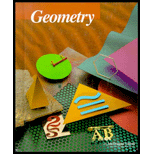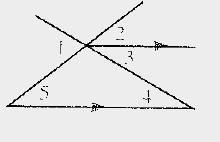
McDougal Littell Jurgensen Geometry: Student Edition Geometry
5th Edition
ISBN: 9780395977279
Author: Ray C. Jurgensen, Richard G. Brown, John W. Jurgensen
Publisher: Houghton Mifflin Company College Division
expand_more
expand_more
format_list_bulleted
Question
Chapter 6, Problem 2CR
To determine
To complete: the given statement using
Expert Solution & Answer
Explanation of Solution
Given information:
The given figure is as follows:

The given statement is “
Calculation:
The vertical
When two lines are intersecting, the vertical angles are congruent.
Thus,
Hence,
Chapter 6 Solutions
McDougal Littell Jurgensen Geometry: Student Edition Geometry
Ch. 6.1 - Prob. 1CECh. 6.1 - Prob. 2CECh. 6.1 - Prob. 3CECh. 6.1 - Prob. 4CECh. 6.1 - Prob. 5CECh. 6.1 - Prob. 6CECh. 6.1 - Prob. 7CECh. 6.1 - Prob. 8CECh. 6.1 - Prob. 9CECh. 6.1 - Prob. 10CE
Ch. 6.1 - Prob. 11CECh. 6.1 - Prob. 12CECh. 6.1 - Prob. 13CECh. 6.1 - Prob. 14CECh. 6.1 - Prob. 15CECh. 6.1 - Prob. 16CECh. 6.1 - Prob. 17CECh. 6.1 - Prob. 18CECh. 6.1 - Prob. 19CECh. 6.1 - Prob. 20CECh. 6.1 - Prob. 1WECh. 6.1 - Prob. 2WECh. 6.1 - Prob. 3WECh. 6.1 - Prob. 4WECh. 6.1 - Prob. 5WECh. 6.1 - Prob. 6WECh. 6.1 - Prob. 7WECh. 6.1 - Prob. 8WECh. 6.1 - Prob. 9WECh. 6.1 - Prob. 10WECh. 6.1 - Prob. 11WECh. 6.1 - Prob. 12WECh. 6.1 - Prob. 13WECh. 6.2 - Prob. 1CECh. 6.2 - Prob. 2CECh. 6.2 - Prob. 3CECh. 6.2 - Prob. 4CECh. 6.2 - Prob. 5CECh. 6.2 - Prob. 6CECh. 6.2 - Prob. 7CECh. 6.2 - Prob. 8CECh. 6.2 - Prob. 9CECh. 6.2 - Prob. 10CECh. 6.2 - Prob. 11CECh. 6.2 - Prob. 12CECh. 6.2 - Prob. 1WECh. 6.2 - Prob. 2WECh. 6.2 - Prob. 3WECh. 6.2 - Prob. 4WECh. 6.2 - Prob. 5WECh. 6.2 - Prob. 6WECh. 6.2 - Prob. 7WECh. 6.2 - Prob. 8WECh. 6.2 - Prob. 9WECh. 6.2 - Prob. 10WECh. 6.2 - Prob. 11WECh. 6.2 - Prob. 12WECh. 6.2 - Prob. 13WECh. 6.2 - Prob. 14WECh. 6.2 - Prob. 15WECh. 6.2 - Prob. 16WECh. 6.2 - Prob. 17WECh. 6.2 - Prob. 18WECh. 6.2 - Prob. 19WECh. 6.2 - Prob. 20WECh. 6.2 - Prob. 21WECh. 6.2 - Prob. 22WECh. 6.2 - Prob. 1MRECh. 6.2 - Prob. 2MRECh. 6.2 - Prob. 3MRECh. 6.2 - Prob. 4MRECh. 6.2 - Prob. 5MRECh. 6.2 - Prob. 6MRECh. 6.2 - Prob. 7MRECh. 6.2 - Prob. 8MRECh. 6.2 - Prob. 9MRECh. 6.3 - Prob. 1CECh. 6.3 - Prob. 2CECh. 6.3 - Prob. 3CECh. 6.3 - Prob. 4CECh. 6.3 - Prob. 5CECh. 6.3 - Prob. 6CECh. 6.3 - Prob. 7CECh. 6.3 - Prob. 8CECh. 6.3 - Prob. 9CECh. 6.3 - Prob. 10CECh. 6.3 - Prob. 1WECh. 6.3 - Prob. 2WECh. 6.3 - Prob. 3WECh. 6.3 - Prob. 4WECh. 6.3 - Prob. 5WECh. 6.3 - Prob. 6WECh. 6.3 - Prob. 7WECh. 6.3 - Prob. 8WECh. 6.3 - Prob. 9WECh. 6.3 - Prob. 10WECh. 6.3 - Prob. 11WECh. 6.3 - Prob. 12WECh. 6.3 - Prob. 13WECh. 6.3 - Prob. 14WECh. 6.3 - Prob. 15WECh. 6.3 - Prob. 16WECh. 6.3 - Prob. 17WECh. 6.3 - Prob. 18WECh. 6.3 - Prob. 19WECh. 6.3 - Prob. 20WECh. 6.3 - Prob. 1ST1Ch. 6.3 - Prob. 2ST1Ch. 6.3 - Prob. 3ST1Ch. 6.3 - Prob. 4ST1Ch. 6.3 - Prob. 5ST1Ch. 6.3 - Prob. 6ST1Ch. 6.3 - Prob. 7ST1Ch. 6.3 - Prob. 8ST1Ch. 6.3 - Prob. 9ST1Ch. 6.3 - Prob. 10ST1Ch. 6.4 - Prob. 1CECh. 6.4 - Prob. 2CECh. 6.4 - Prob. 3CECh. 6.4 - Prob. 4CECh. 6.4 - Prob. 5CECh. 6.4 - Prob. 6CECh. 6.4 - Prob. 7CECh. 6.4 - Prob. 8CECh. 6.4 - Prob. 9CECh. 6.4 - Prob. 10CECh. 6.4 - Prob. 11CECh. 6.4 - Prob. 12CECh. 6.4 - Prob. 13CECh. 6.4 - Prob. 14CECh. 6.4 - Prob. 15CECh. 6.4 - Prob. 16CECh. 6.4 - Prob. 17CECh. 6.4 - Prob. 18CECh. 6.4 - Prob. 19CECh. 6.4 - Prob. 20CECh. 6.4 - Prob. 1WECh. 6.4 - Prob. 2WECh. 6.4 - Prob. 3WECh. 6.4 - Prob. 4WECh. 6.4 - Prob. 5WECh. 6.4 - Prob. 6WECh. 6.4 - Prob. 7WECh. 6.4 - Prob. 8WECh. 6.4 - Prob. 9WECh. 6.4 - Prob. 10WECh. 6.4 - Prob. 11WECh. 6.4 - Prob. 12WECh. 6.4 - Prob. 13WECh. 6.4 - Prob. 14WECh. 6.4 - Prob. 15WECh. 6.4 - Prob. 16WECh. 6.4 - Prob. 17WECh. 6.4 - Prob. 18WECh. 6.4 - Prob. 19WECh. 6.4 - Prob. 20WECh. 6.4 - Prob. 21WECh. 6.4 - Prob. 22WECh. 6.4 - Prob. 23WECh. 6.4 - Prob. 24WECh. 6.4 - Prob. 1AECh. 6.4 - Prob. 2AECh. 6.4 - Prob. 1BECh. 6.4 - Prob. 2BECh. 6.4 - Prob. 3BECh. 6.5 - Prob. 1CECh. 6.5 - Prob. 2CECh. 6.5 - Prob. 3CECh. 6.5 - Prob. 4CECh. 6.5 - Prob. 5CECh. 6.5 - Prob. 6CECh. 6.5 - Prob. 7CECh. 6.5 - Prob. 8CECh. 6.5 - Prob. 9CECh. 6.5 - Prob. 10CECh. 6.5 - Prob. 1WECh. 6.5 - Prob. 2WECh. 6.5 - Prob. 3WECh. 6.5 - Prob. 4WECh. 6.5 - Prob. 5WECh. 6.5 - Prob. 6WECh. 6.5 - Prob. 7WECh. 6.5 - Prob. 8WECh. 6.5 - Prob. 9WECh. 6.5 - Prob. 10WECh. 6.5 - Prob. 11WECh. 6.5 - Prob. 12WECh. 6.5 - Prob. 13WECh. 6.5 - Prob. 14WECh. 6.5 - Prob. 15WECh. 6.5 - Prob. 1ST2Ch. 6.5 - Prob. 2ST2Ch. 6.5 - Prob. 3ST2Ch. 6.5 - Prob. 4ST2Ch. 6.5 - Prob. 5ST2Ch. 6.5 - Prob. 6ST2Ch. 6.5 - Prob. 7ST2Ch. 6.5 - Prob. 8ST2Ch. 6.5 - Prob. 9ST2Ch. 6 - Prob. 1CRCh. 6 - Prob. 2CRCh. 6 - Prob. 3CRCh. 6 - Prob. 4CRCh. 6 - Prob. 5CRCh. 6 - Prob. 6CRCh. 6 - Prob. 7CRCh. 6 - Prob. 8CRCh. 6 - Prob. 9CRCh. 6 - Prob. 10CRCh. 6 - Prob. 11CRCh. 6 - Prob. 12CRCh. 6 - Prob. 13CRCh. 6 - Prob. 14CRCh. 6 - Prob. 15CRCh. 6 - Prob. 16CRCh. 6 - Prob. 17CRCh. 6 - Prob. 18CRCh. 6 - Prob. 1CTCh. 6 - Prob. 2CTCh. 6 - Prob. 3CTCh. 6 - Prob. 4CTCh. 6 - Prob. 5CTCh. 6 - Prob. 6CTCh. 6 - Prob. 7CTCh. 6 - Prob. 8CTCh. 6 - Prob. 9CTCh. 6 - Prob. 10CTCh. 6 - Prob. 11CTCh. 6 - Prob. 12CTCh. 6 - Prob. 13CTCh. 6 - Prob. 14CTCh. 6 - Prob. 15CTCh. 6 - Prob. 16CTCh. 6 - Prob. 1ARCh. 6 - Prob. 2ARCh. 6 - Prob. 3ARCh. 6 - Prob. 4ARCh. 6 - Prob. 5ARCh. 6 - Prob. 6ARCh. 6 - Prob. 7ARCh. 6 - Prob. 8ARCh. 6 - Prob. 9ARCh. 6 - Prob. 10ARCh. 6 - Prob. 11ARCh. 6 - Prob. 12ARCh. 6 - Prob. 13ARCh. 6 - Prob. 14ARCh. 6 - Prob. 15ARCh. 6 - Prob. 16ARCh. 6 - Prob. 17ARCh. 6 - Prob. 18ARCh. 6 - Prob. 19ARCh. 6 - Prob. 1CURCh. 6 - Prob. 2CURCh. 6 - Prob. 3CURCh. 6 - Prob. 4CURCh. 6 - Prob. 5CURCh. 6 - Prob. 6CURCh. 6 - Prob. 7CURCh. 6 - Prob. 8CURCh. 6 - Prob. 9CURCh. 6 - Prob. 10CURCh. 6 - Prob. 11CUR
Additional Math Textbook Solutions
Find more solutions based on key concepts
A categorical variable has three categories, with the following frequencies of occurrence: a. Compute the perce...
Basic Business Statistics, Student Value Edition
The four flaws in the given survey.
Elementary Statistics
Suppose that A and B are mutually exclusive events for which P(A) = .3 and P(B) = .5. What is the probability t...
A First Course in Probability (10th Edition)
Views on Capital Punishment Use the data given in Exercise 7.23. Make the two given tables into one table by co...
Introductory Statistics
Identify f as being linear, quadratic, or neither. If f is quadratic, identify the leading coefficient a and ...
College Algebra with Modeling & Visualization (5th Edition)
Identifying Type I and Type II Errors In Exercises 31–36, describe type I and type II errors for a hypothesis t...
Elementary Statistics: Picturing the World (7th Edition)
Knowledge Booster
Learn more about
Need a deep-dive on the concept behind this application? Look no further. Learn more about this topic, geometry and related others by exploring similar questions and additional content below.Similar questions
- 5. 156 m/WXY = 59° 63 E 7. B E 101 C mFE = 6. 68° 8. C 17arrow_forward1/6/25, 3:55 PM Question: 14 Similar right triangles EFG and HIJ are shown. re of 120 √65 adjacent E hypotenuse adjaca H hypotenuse Item Bank | DnA Er:nollesup .es/prist Sisupe ed 12um jerit out i al F 4 G I oppe J 18009 90 ODPO ysma brs & eaus ps sd jon yem What is the value of tan J? ed on yem O broppo 4 ○ A. √65 Qx oppoEF Adj art saused taupe ed for yem 4 ○ B. √65 29 asipnisht riod 916 zelprisht rad √65 4 O ○ C. 4 √65 O D. VIS 9 OD elimiz 916 aelonsider saused supsarrow_forwardFind all anglesarrow_forward
- Find U V . 10 U V T 64° Write your answer as an integer or as a decimal rounded to the nearest tenth. U V = Entregararrow_forwardFind the area of a square whose diagonal is 10arrow_forwardDecomposition geometry: Mary is making a decorative yard space with dimensions as shaded in green (ΔOAB).Mary would like to cover the yard space with artificial turf (plastic grass-like rug). Mary reasoned that she could draw a rectangle around the figure so that the point O was at a vertex of the rectangle and that points A and B were on sides of the rectangle. Then she reasoned that the three smaller triangles resulting could be subtracted from the area of the rectangle. Mary determined that she would need 28 square meters of artificial turf to cover the green shaded yard space pictured exactly.arrow_forward
- 7. 11 m 12.7 m 14 m S V=B₁+ B2(h) 9.5 m 16 m h+s 2 na 62-19 = 37 +, M h² = Bu-29arrow_forwardwhat would a of a interscribed angle be with an arc of 93 degrees and inside abgles of 111 and 98arrow_forwardPlease complete through GeoGebra and present the screenshots of the results. Thanks! (This supports on how to submit it.)arrow_forward
arrow_back_ios
SEE MORE QUESTIONS
arrow_forward_ios
Recommended textbooks for you
 Elementary Geometry For College Students, 7eGeometryISBN:9781337614085Author:Alexander, Daniel C.; Koeberlein, Geralyn M.Publisher:Cengage,
Elementary Geometry For College Students, 7eGeometryISBN:9781337614085Author:Alexander, Daniel C.; Koeberlein, Geralyn M.Publisher:Cengage, Elementary Geometry for College StudentsGeometryISBN:9781285195698Author:Daniel C. Alexander, Geralyn M. KoeberleinPublisher:Cengage Learning
Elementary Geometry for College StudentsGeometryISBN:9781285195698Author:Daniel C. Alexander, Geralyn M. KoeberleinPublisher:Cengage Learning

Elementary Geometry For College Students, 7e
Geometry
ISBN:9781337614085
Author:Alexander, Daniel C.; Koeberlein, Geralyn M.
Publisher:Cengage,

Elementary Geometry for College Students
Geometry
ISBN:9781285195698
Author:Daniel C. Alexander, Geralyn M. Koeberlein
Publisher:Cengage Learning
Orthogonality in Inner Product Spaces; Author: Study Force;https://www.youtube.com/watch?v=RzIx_rRo9m0;License: Standard YouTube License, CC-BY
Abstract Algebra: The definition of a Group; Author: Socratica;https://www.youtube.com/watch?v=QudbrUcVPxk;License: Standard Youtube License